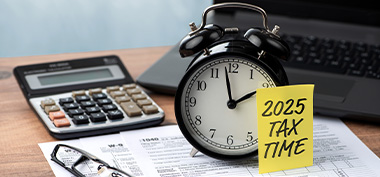January 12, 2025
Preparing for Tax Season?
Ideas for managing your refund safely and securely

Here are some ideas to help your money arrive quickly and safely, once you have submitted your federal taxes and expect a refund coming to you. Consider these safe ways to receive and manage your refund.
Find out if you may be eligible for free tax-preparation assistance through the IRS
The Internal Revenue Service (IRS) Volunteer Income Tax Assistance (VITA) and Tax Counseling for the Elderly (TCE) programs offer free basic tax return preparation to qualified individuals.
The tax refund process and benefits of a bank account
The fastest way to get your tax refund is to have the IRS electronically deposit the refund into your bank account. This service is free, and it allows you to deposit your refund into as many as three separate accounts. While you can receive your refund in the form of a paper check, there are several advantages to direct deposit. Not only is it faster, direct deposit is also more secure. Refund checks sent through the mail can be lost, stolen, or returned to the IRS, if undeliverable. If you don’t already have a bank account, this might be the perfect time to open one. The FDIC provides deposit insurance to protect your money in the event of a bank failure. Your deposits are automatically insured to at least $250,000 at each FDIC-insured bank.
Tracking your refund status
Whichever refund delivery method you choose, you can track the status of your federal tax return from the time the IRS received it by IRS Where's My Refund.
Protect your money from tax scams
Scammers can use your information to open credit card and loan accounts or file a fraudulent tax return in your name. This information also allows a thief to claim your refund. If you suspect that your information was stolen, contact the IRS by calling 800-908-4490 and visit the IRS website for identity theft resources.
Identity thieves have also been known to pose as IRS agents, providing fake names and IRS badge numbers. The IRS initiates most contacts through regular mail delivered by the United States Postal Service. Before acting on any phone call or email purportedly from the IRS, call the agency at 800-829-1040 or check its website for verification resources.
If you believe the contact was part of a scam, also report it to the Treasury Inspector General for Tax Administration (Tax IG) by calling 800-366-4484 or reporting the scam on the Tax IG website.
What to do with your refund
Tax refunds can provide a great opportunity to start a new savings account, contribute to your emergency fund, or reduce outstanding debt. Because you can split your refund, you are able to use each of these options.
Consider using your refund to start or supplement an emergency savings fund. Having emergency savings provides peace of mind when an unexpected need arises, such as a major car or home repair. A general recommendation is to try to keep three to six months’ worth of expenses in your emergency savings fund.
If you are carrying a credit card balance, think about using your tax refund to pay it down or even pay it off. To get the most from your money, it may make sense to pay off a credit card with a high interest rate, with interest compounding month after month. Going this route can help improve your credit history as you reduce your debt.
Making extra payments on your mortgage is another way to use your refund, saving you money over the long term. If much of your mortgage payment goes toward paying interest, using your tax refund to make an extra payment or two against the principal can go a long way to reducing the debt and overall cost of the loan.
If you are getting a tax refund this year, remember to take steps to keep your refund safe, know the refund options available to you, and consider different ways to make your money work harder for you.

